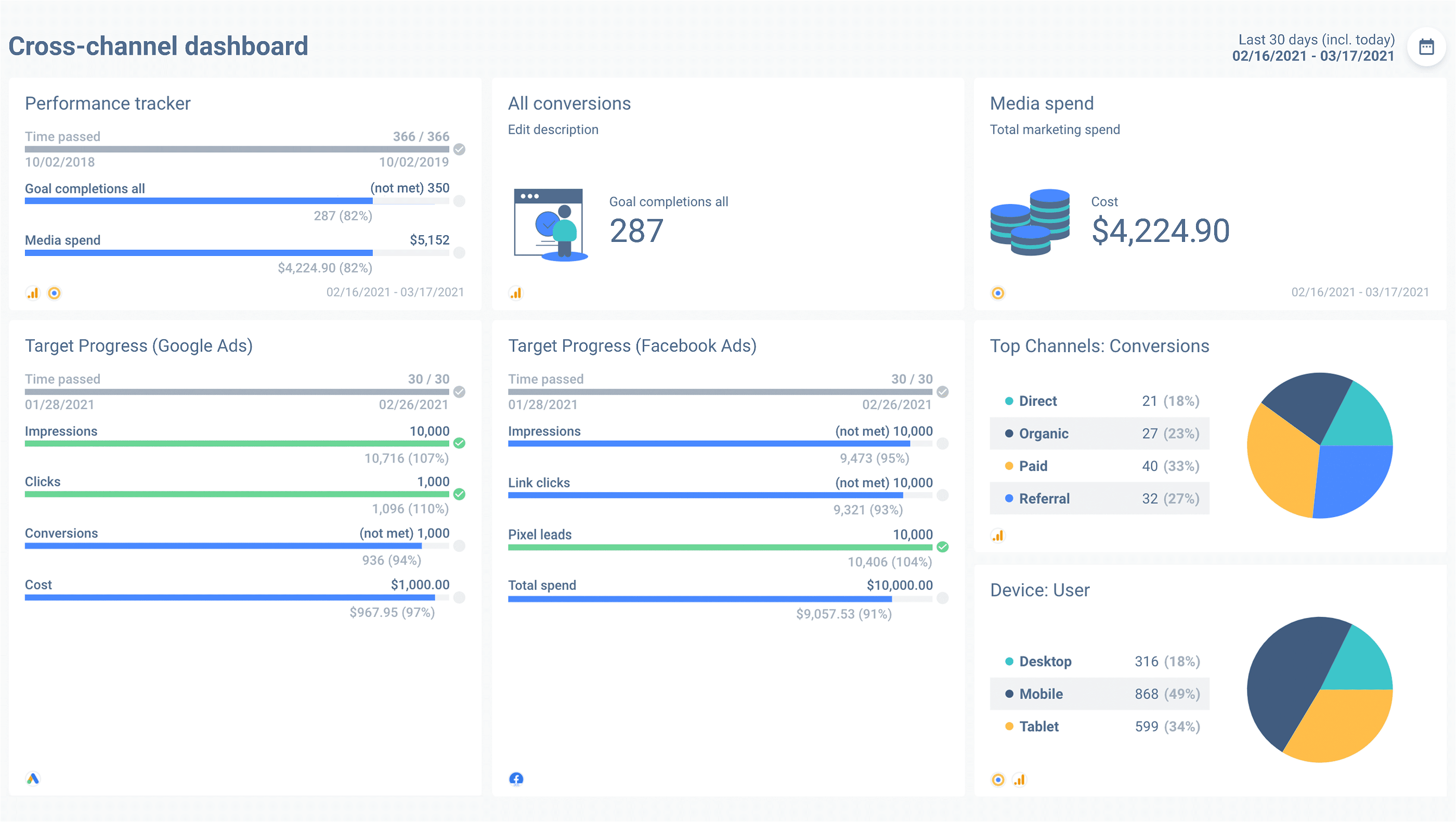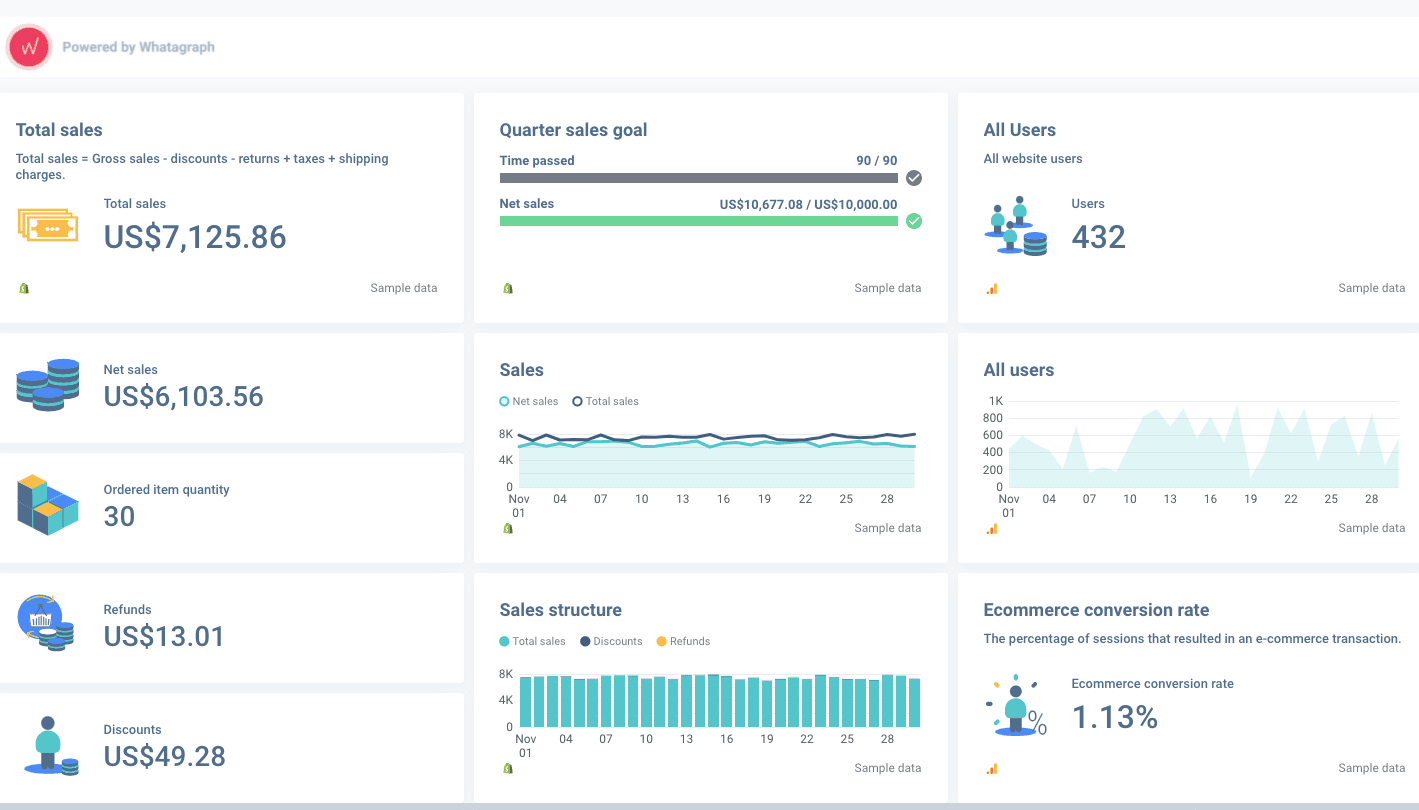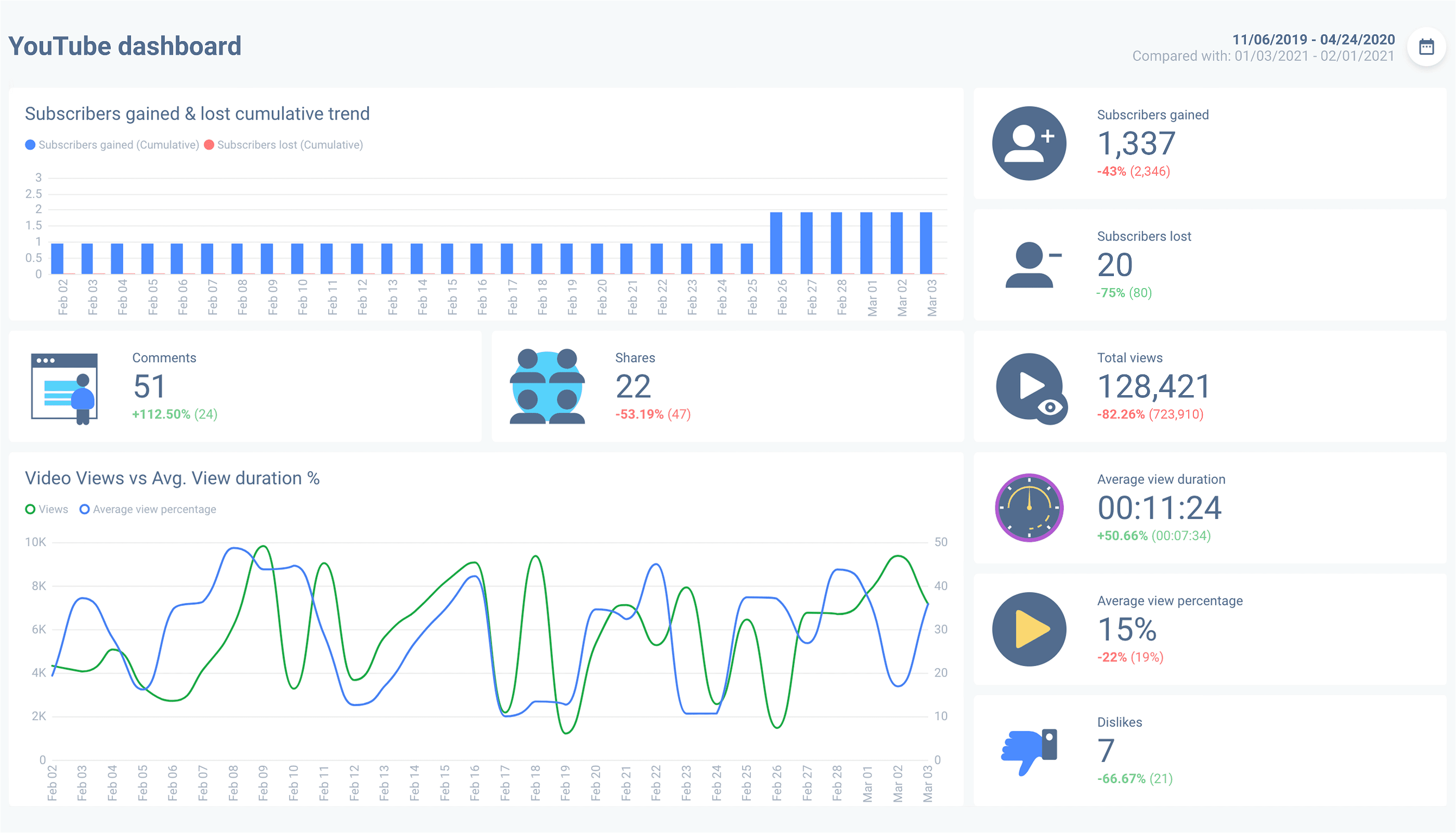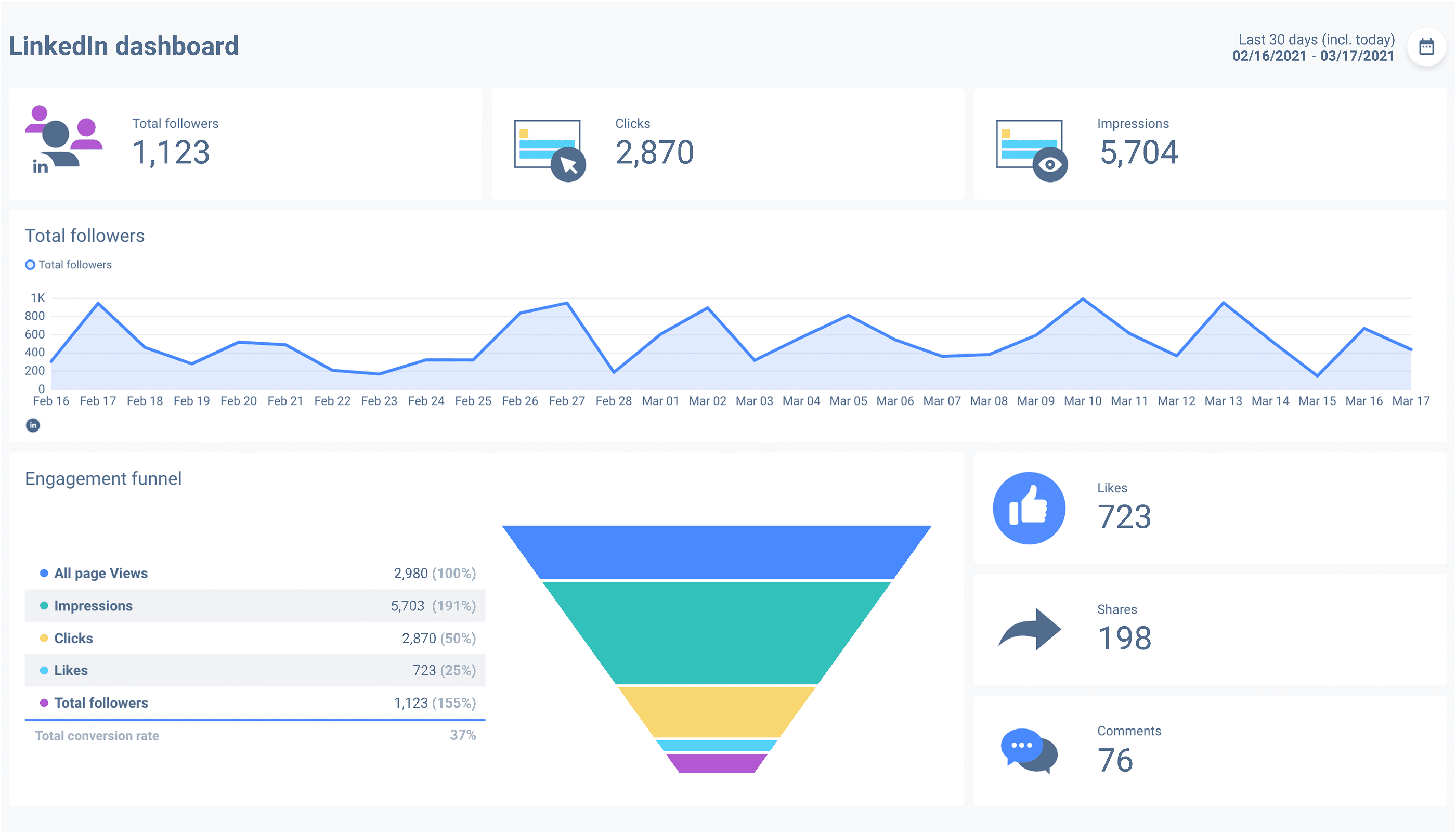13 Best Practices for Dashboard Design
Monitoring marketing data takes ingenuity. Dashboards are a great way to display essential data necessary to achieve a particular objective. A good dashboard design will provide complex data visualization most comprehensively. But to create an operational dashboard, you need to know basic dashboard design principles that will guide you to the best design you can build yourself.

Apr 09 2020 ● 10 min read

What Is The Purpose of Dashboards?
Dashboards present the most relevant data for stakeholders at the moment they are looking at it. A good dashboard will present live data for instant situational awareness, which is especially useful for agencies.
Dashboard users should be able to understand and interpret the most important data, form key insights and evaluate the progress towards key performance indicators (KPIs). A well-prepared board will show all the data on a visual display, showing only the most critical data points.
Dashboard example: in this cross-channel dashboard, there's data coming from a minimum of 5 different channels. See how this dashboard design handles such complex data and presents it in an easy-to-understand way.

Another purpose of a dashboard is quick identification of issues. This will enable users to dive straight into problematic marketing areas without wasting time digging through multiple data channels.
This is a successful dashboard example built with Whatagraph. It offers a visual representation of different campaigns on a high level without going into too much detail. However, it shows key information that gives the user access to the deeper inspection of problems and allows focus.
Best Practices for Dashboard Design
So we're aiming for a dashboard design that shows useful metrics from real-time data sources and showcases business objectives in a single window.
It sounds quite a challenge, and it is. But with these essential dashboard design tips, you will be presenting data professionally in no time.
1. Determine the Purpose
To display information on the dashboard accurately, you must first determine the purpose it will serve. Dashboards are divided into several categories based on their purpose. The broadest and the most common categories are analytical dashboards and operational dashboards. They can also have a narrower category, like the financial dashboards, sales dashboards and even strategic dashboards.
The main goal of operational dashboards is to communicate relevant information quickly and clearly to users who need to take immediate action. They are time-sensitive and help users to be proactive and efficient.
Dashboard example: this Shopify + Google Analytics dashboard was created with the purpose of monitoring sales goals achievement. From it, you can easily read the data on active website users, total sales and sale goals, conversion rate and more - all in a single window.

On the other hand, analytical dashboards are less time-sensitive and focus on helping readers analyze trends, make the best sense of the data, and drive decision making. These two categories may take two completely different approaches to dashboard design.
When designing either of these dashboard formats, think about what data users expect to see. If their focus is on time-sensitive data, choose appropriate metrics with a visual-first approach without going into too many details.
On the other hand, if your dashboard is analytical and serves to drive business strategies, you can afford to go into more details.
3. Simple Form
For an excellent dashboard design, one of the main goals is to present the relevant information in a simple and easy-to-understand form. For this purpose, you can consider using a dashboard reporting tool.
So, don't present too much information or use more columns to do that. Get rid of any redundant information. Utilize white space, leaving just enough for the viewer to comprehend the data structure.
4. Consistency
Your general dashboard design has to stay consistent. Once you determine the dashboard's purpose, establish its visual hierarchy and form, you cannot suddenly change these rules. Data is only one part of the overall consistency. You can't control what marketing channels produce as data, but you can control how you design and present relevant data.
Consistency comes in different forms. Small things like following consistent date formatting and naming conventions can make things easier for the user. Presenting data in line charts, pie charts, radar charts and bar charts of the same style will also help the user process data more accessible.
5. Proximity
To help readers understand the information more easily and quickly, you should present related details closer to each other instead of scattering it across the entire dashboard.
6. Alignment
Dashboard elements should be aligned with each other for a balanced look which enables a good user experience. Grids allow you to obtain effective consistency and alignment and make a template for your dashboard design.
Dashboard example: here you see a perfectly aligned grid. 2/3 of the dashboard show performance over a longer period of time through different dimensions. The 1/3 of the dashboard on the right is neatly stacked to show only the most relevant statistics needed for insights.

7. Whitespace
Whitespace plays an important role in your dashboard design. It allows the reader to take a break from seeing all the information and leaves more time to process the data. Using whitespace prevents cluttered view and helps you to group related information visually. You might have heard it called negative space as well.
8. Color
Color plays a significant role in an effective dashboard design. Choosing the right colors and using maximum contrast can help you guide the reader through the information in a simple and easy-to-understand way. It can make the content easier to read. So, make sure to contrast colors and avoid using inefficient gradients.
9. Fonts
Unless there's no reason to use a specific font, use the standard ones for your dashboard content. They are easier to scan, read, and understand. Don't use ALL caps text since it makes the reading more difficult.
So, choose a standard font with a suitable size to present the information. Fonts like Times New Roman, Arial, Roboto and Calibri will do the trick.
10. Number Formats
Use round numbers instead of long numbers whenever possible to prevent confusing the reader. Don't forget to add a note that "numbers might not add up due to rounding". It's an easy way to explain why sometimes pie charts don't add up to a hundred or other similar cases.
11. Labels
Rotated labels are generally more difficult to read and absorb for the human mind. Therefore, use labels that communicate the information quickly and effectively. Standard abbreviations should be used whenever possible.
Dashboard example: in this LinkedIn dashboard, all numbers and graphs are labelled with one or two words. It makes the dashboard look uncluttered and less intimidating, while still providing necessary information.

12. Personalization and Customization
Readers expect to find relevant information on their dashboard, and the two techniques that allow this to happen are personalization and customization.
Personalization is when you a dashboard design that adheres to your client's brand image. This can mean adding a logo design, choosing appropriate chart colors or adding specific labels to metrics or channels.
Customization is adapting the dashboard design to display relevant data and different key metrics. It can mean rearranging the dashboard assets to present data in another way. Or pick out and highlight different KPIs to match the interest of the client.
When designing dashboards, both personalization and customization should work in tandem.
13. Data Tables or Lists
Integrating data tables is useful when you have a lot of information for different items to present. They are the best way to present information such as a list of clients with their ID, last activity, contacts, status, etc.
Data tables provide easy scalability, good use of space and can make the design process less complicated. They are easy to work with, as most people have experience in working with Microsoft Excel. Just make sure to make tables and lists less intimidating!
To Sum Up
Dashboards are supposed to deliver complex data in a simple way that would save time and effort. They should be structured in a way that will maintain a visual hierarchy. Whether or not they will serve this purpose depends on the dashboard design, which should be goal-centric and user-centred.
Even though each dashboard has a unique goal, limitations, and requirements, following these best practices will help you create excellent dashboard designs.
The dashboard design best practices also apply to reports, about which you can learn more here.
Published on Apr 09 2020

WRITTEN BY
Indrė Jankutė-CarmaciuIndrė is a copywriter at Whatagraph with extensive experience in search engine optimization and public relations. She holds a degree in International Relations, while her professional background includes different marketing and advertising niches. She manages to merge marketing strategy and public speaking while educating readers on how to automate their businesses.